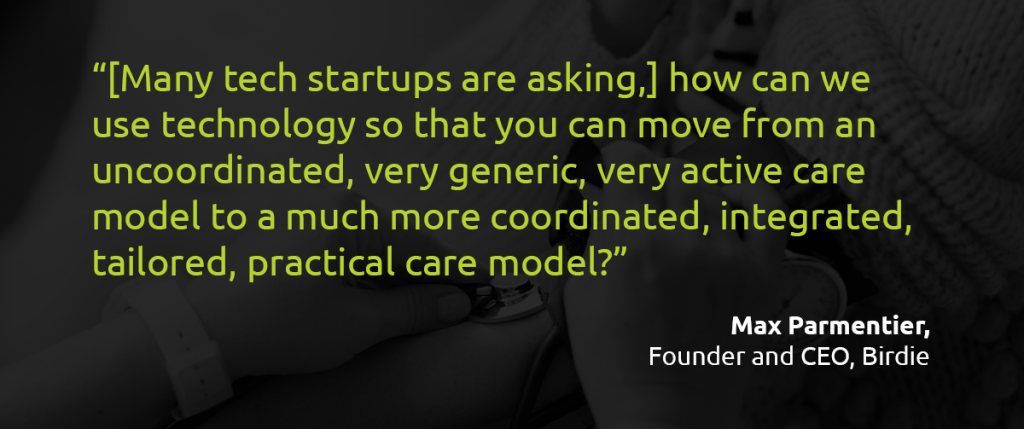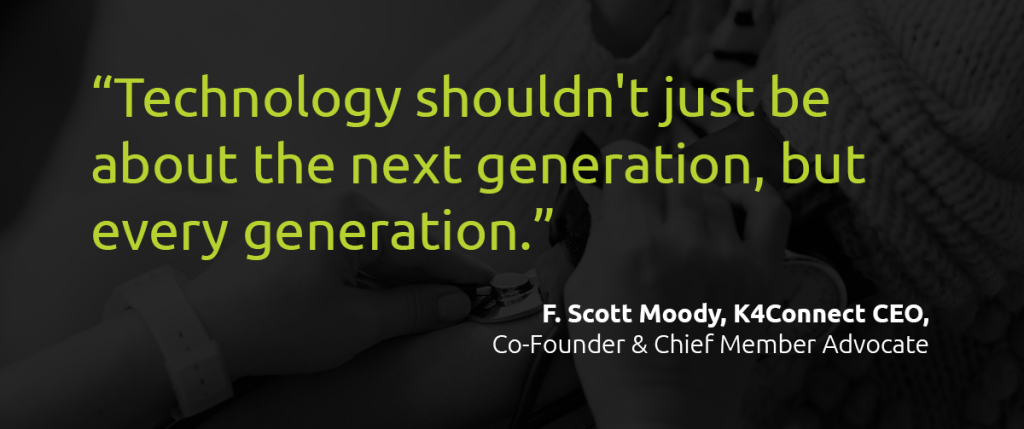Health Apps Aren’t Just for the Young
Perhaps no idea is more hotly debated than that of restructuring healthcare and the insurance market to meet the growing demand and the needs of various populations. There are plenty of comprehensive plans that call for tearing down the current systems and restructuring them from the ground up.
We also need to keep in mind that not only systems are feeling the burden. Constrained resources mean that professional caregivers are being asked to provide personal attention to more people while keeping an eye on costs. It’s challenging to say the least to focus on the needs of the individual, while also being mindful of whether every minute they spend is reimbursable.
At the end of the day, the growing eldercare challenge is much bigger than the healthcare system. It involves individuals at every level and of every age. But if RGAX’s experience in insurtech has taught me anything, it’s that big problems can sometimes be best solved with a series of small solutions. We are seeing innovators around the world stepping up to the challenge, a few of which I had the opportunity to discuss in my Future of Healthcare roundtable with healthcare technologists, Dr. James Somauroo, Amer Fasihi, and Max Parmentier.

What’s in a Name?
Many in this space refer to these technologies as agetech because they are focused on helping the elderly live healthier, longer, more fulfilling lives. However, comprehensive applications like TCare are also designed to help those who care for the elderly, as well as those who aren’t necessarily aged but are dealing with disabilities or other chronic conditions.
Healthtech is another common term as many of these solutions are focused on the health of the individual, both body and mind. But healthtech often brings to mind fitness trackers and personal wellness devices, not applications like K4Connect that also cover everything from the individual’s living environment to the running of the facility.
Our work with insurance carriers at RGAX leads us to categorize these applications as insurtech. Even though not all of the application developers start out as insurtech startups developed by or in collaboration with a carrier, many end up following this path to the great benefit of their organizations, the carriers, and the people they serve. Everyone benefits when costs are reduced and outcomes improve.
Regardless of what you call these solutions, there are many that are already having a tremendous, positive impact on the lives of the elderly and their caregivers:
Agetech/Healthtech/Insurtech Examples
- CarePredict: Utilizes a wrist-worn wearable that detects location in real-time, tracks daily living activities and offers two-way audio communication between users and caregivers for remote assistance, emergency response support, and fall alerts.
- Essence: A connected home environment with intelligent voice command capabilities, enabling users to remotely control their environment and benefit from voice-activated panic detectors, proactive medication adherence alerts, and other various sensors that monitor health signs and daily activity levels.
- GPS Smartsole: Smart shoe soles inlaid with GPS allow families to follow the location of loved ones in real-time.
- DFree: A wearable device that monitors bladder fullness to help prevent urinary incontinence.
- K4Connect: Started as a developer of Smart Home solutions, K4Connect provides long-term care residents with smart solutions to promote engagement, wellness, and a better quality of life while providing insights for facility staff and operators to help them provide more effective care.
- Peerbridge Cor: Wearable chest sensors replace old-fashioned, cumbersome holters to detect and monitor unnatural heart rhythms and transmit health information directly to physicians.
- PARO: A therapeutic robot in the form of a seal. Voice and touch-sensitive, the lifelike robot stimulates interaction with users to improve socialization, reduce stress, and have other positive psychological effects on users as well as caregivers.
- Tango: A digital belt that gathers and transmits data on posture, walking speed, and gait. In the event of an accident, the belt can deploy airbags to reduce impact force and prevent hip injury.
- TCare: An application that helps professional caregivers recognize the signs of burnout in family caregivers and intervene before the problem becomes a crisis.

The Power of Data
The increasingly diverse technology landscape includes not only applications, but also various wearable items, wireless devices, and other monitoring tools embedded with smart sensors and GPS capabilities. While helping seniors remain active, these devices also track daily activities (e.g., diet, movement, sleep patterns, vital signs) and transmit data to family members, caregivers, and other healthcare professionals to help them proactively identify behavioral and functional changes that may indicate age- or condition-related deterioration.
The ability to pre-empt health issues is one aspect that makes healthtech/agetech so attractive to insurance carriers and others concerned with controlling the cost of care. It’s well recognized that the majority of healthcare costs come from the top 5% or so of people classified as high utilizers. Often, these individuals fall into high risk categories, such as those managing chronic conditions.
Applications can help these individuals and their caregivers manage their care for better outcomes at a lower cost. Through predictive analytics, they can even help identify those individuals who are at risk of becoming high utilizers, allowing caregivers and family members to intervene before a problem becomes a crisis.
When aggregated, data can also be used to assess population health, providing carriers, community officials, legislators, and others with deeper insights into the changing needs of various population segments.
Accelerating Eldercare Innovation
Despite the challenges, the future of eldercare is promising. Many carriers are striving to help the elderly live better, while remaining independent. By fostering innovation and partnering with agetech startups expert in solving problems for their customers, the industry has an opportunity to collaborate on solutions that help the elderly live longer and healthier lives, while also supporting those who care for them.
Join our community of innovators eager to transform the life insurance industry.
Subscribe to the RGAX blog >

